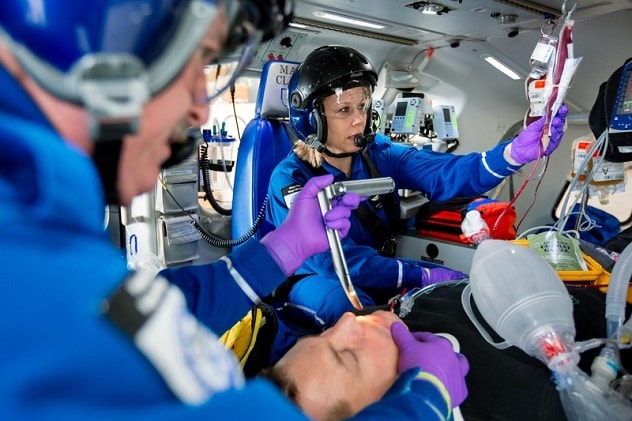Jan. 17, 2024
Standard process dictates that an injured patient should be transported to the closest trauma center with appropriate capabilities. Patients can be transferred to Level III or IV trauma facilities, or more severely injured patients or those who require specialty care can be transferred to a Level I or II trauma center.
Before transferring a patient, call ahead so the receiving center's personnel can be briefed and ready to handle the injured patient's care. Also, to note, there are times that lifesaving care will need to be delivered at the scene or at an initial Level III or IV trauma center before the patient can safely be transferred for definitive care.
The care team at the referring center should determine the mode of transport for patient transfer as well as the level of care needed during transfer. Considerations include distance between centers and patient stability, as well as ongoing patient care needs.
The importance of standardized protocol
Though using one's clinical judgment is important, Erica A. Loomis, M.D., a trauma surgeon at Mayo Clinic in Minnesota, indicates that use of standard Advanced Trauma Life Support (ATLS) protocols is critical so that nothing is missed in the patient's assessment. ATLS also ensures that healthcare professionals share patient information using a common language.
"If we are disorganized in our initial assessments or in how we convey information to other teams, patient outcomes can suffer," says Dr. Loomis. Dr. Loomis also serves as associate medical director for Midwest Input and Admissions, Hospital Operations Command Center and Optimization at Mayo Clinic. "An organized process also is why basic trauma management involves beginning with the greatest threats to life."
When and where to transfer
Dr. Loomis recommends when a patient who has experienced traumatic injury is stabilized to the best of your trauma center's ability and has an injury unsuitable for your center's ongoing care — related to capabilities, equipment or lack of capacity — it is time to transfer the patient. Unless transfer is purely related to a capacity issue, transfer from a Level IV to a Level III trauma center is uncommon, due to fewer distinctions between these levels. It is key to know the specific capabilities of each trauma center in your region, as some may have more services than others of the same level. Dr. Loomis points out that Mayo Clinic Health System in Mankato, Minnesota, for example, offers more services than other Level III trauma centers, including plastic surgery and neurosurgery.
Beyond what other trauma centers in your region typically offer, another key transfer consideration is knowledge of what a center has available on that particular day. For instance, if the patient needs a neurosurgeon who is not present in the hospital that day, that center will be an inappropriate transfer. If the patient also requires dialysis while hospitalized, you will want to confirm that this service is available.
"People working in a given area should know the capabilities of different regional centers, what types of injuries can be treated at their own center, and what types of injuries are appropriate for stopgap stabilizing care and then transfer elsewhere," says Dr. Loomis.
Though most trauma centers do not go on trauma or emergency department diversion, Dr. Loomis says that being aware of where this applies on a given day is crucial.
Optimizing the transfer process
Dr. Loomis underlines factors in an optimal transfer for best outcomes for injured patients:
Call ahead. The referring healthcare professional should contact the Midwest Admission and Transfer Center to arrange transfer of an injured patient. Nurses in the transfer center are experts in patient movement. They will collect patient information and accept the patient to the appropriate emergency department before transport. Call the transfer center team at 507-255-2910 for any transfer questions. The transfer center team will connect you with an emergency medicine specialist, a trauma surgeon or a subspecialist at the receiving center to assist.
Be quick. While precision is important, time is of the essence in the care of the injured patient. Dr. Loomis indicates that transfers should be streamlined and not delayed by unnecessary procedures or imaging prior to transfer.
"You don't need to rush an assessment, but don't delay transfer," says Dr. Loomis.
 Ground transfer
Ground transfer
EMTs load a patient onto a ground ambulance.
 Air transfer
Air transfer
EMTs provide care for a patient in an air ambulance.
Carefully assess all pertinent conditions. To determine the best possible transport for a patient, first contemplate the injury's severity and how far the patient needs to be transported. Before considering air transport — an expensive resource — determine if ground transport is safe for the patient. If a patient's needs dictate air transport, ponder the injury's severity, weather and travel distance to assess whether air is the best decision. She emphasizes that air transport is not a wise use of resources for a minor injury. If a patient sent by ground is not faring well midtransport, contact emergency communication services. This group will send air transport to intercept the ambulance and deliver the patient more rapidly to definitive care.
Make a succinct report. To expedite a patient's transfer to definitive trauma care, Dr. Loomis suggests offering information to the receiving center about the patient plus the assessment and treatment provided in a brief, organized fashion. Specifically, this would involve describing the mechanism of injury, the patient's condition and treatment administered stepwise following the ABCDEs of trauma or by proceeding in head-to-toe order for a well-structured report.
"It's critical to be organized by knowing options for the patient and by giving a concise report, because traumatic injuries could mean a life-or-death situation," says Dr. Loomis.
For more information
Refer a patient to Mayo Clinic.